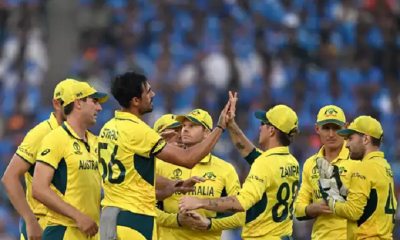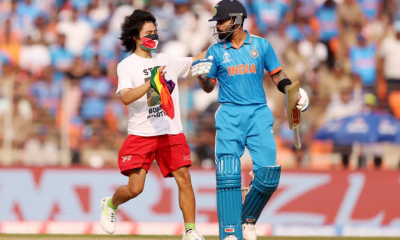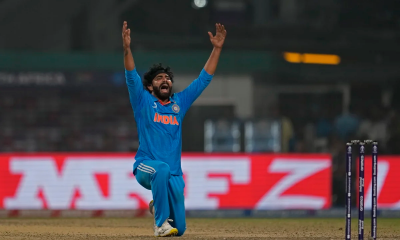Latest News
Shami’s five-fer after Mitchell ton keeps New Zealand to 273

Daryl Mitchell’s career-best 130 and a 159-run third wicket stand with Rachin Ravindra (75) saw New Zealand post 273 in their World Cup 2023 encounter against India in Dharamsala. Helping New Zealand rebuild from a precarious 19/2, Mitchell and Ravindra set a solid platform for the late surge but the hosts pulled things back remarkly at the backend with regular wickets, inspired by Mohammed Shami’s 5-54.
Early strikes from Mohammed Siraj and Shami in an excellent PowerPlay upfront had New Zealand in early trouble after being put in to bat. Devon Conway fell without opening his account, trying to flick a full ball on the pads that was intercepted by a diving Shreyas Iyer at square leg. Shami then struck off his very first ball in the tournament, getting Will Young to drag an inside edge onto his stumps. New Zealand had only 34/2 from the Powerplay – third lowest score in that phase this World Cup – helped only by a generous offering of wides in the 10th over from Siraj.
Mitchell then joined hands with Ravindra to together bail New Zealand out with their big partnership. Ravindra had a fair bit of brush with DRS and lifelines, and made India pay. He hadn’t even opened his account when, against Jasprit Bumrah’s advice, India burnt a review early on a LBW call that was turned down on-field. He was given out caught behind on six off Shami but got out of it using a review himself. He was later reprieved in the same over when his namesake dropped a knee-high regulation catch at backward point. Post a 56-ball half-century, he was adjudged LBW but had it overturned when the replays confirmed the ball was pitching outside leg.
The spinners barely got any turn – Jadeja bowled his 10 on the trot without any break while Mitchell laid into Kuldeep Yadav early, not allowing him to settle down as he deposited two in his succeeding overs straight down the ground. He was the face of New Zealand’s counterattack in the middle-overs, raising his second half-century of the World Cup in 60 balls and going on to convert it into a run-a-ball 100 by the 41st over. He also had his fair share of luck with KL Rahul spilling a tough chance behind on 59 and then Bumrah dropping another sitter when he was on 69.
Shami eventually came to India’s rescue as he broke the stubborn stand, triggering the collapse around a well-set Mitchell. After three spilled chances, India finally managed to cling on to one when Ravindra lofted Shami straight into the waiting hands of long-on, bringing curtains on the 159 partnership. Kuldeep returned with an improved show and earned his reward as he trapped Tom Latham LBW. The New Zealand captain was however coerced into burning a review by Mitchell.
This was followed by a 40-ball phase where the hosts didn’t concede a single boundary to the New Zealand power-hitters. Glenn Phillips duly broke the shackles with a six behind square to welcome Siraj back into the attack at death. His cameo was short-lived though, and ended on 23 with a top-edge off an attempted slog that Rohit Sharma pouched safely amidst three converging fielders.
Bumrah opened his account in his penultimate over of the day, courtesy a well-judged catch from Kohli as he charged in and took a low grab to send Mark Chapman packing on just 6. Shami added three more scalps to his tally at death, perfectly executing a couple of yorkers to knock down the off-stump of Mitchell Santner and the leg-stump of Matt Henry off successive balls in the 48th over. Mitchell dented his figures a tad by launching another one onto the sight-screen in the final over but holed out one ball later, giving Shami a five-wicket haul in his first game of this World Cup.
Brief scores:
New Zealand 273 all out in 50 overs (Daryl Mitchell 130, Rachin Ravindra 75; Mohammed Shami 5-54, Kuldeep Yadav 2-73) vs India
(Cricbuzz)
Latest News
Navy intercepts craft with packages suspected to be narcotics
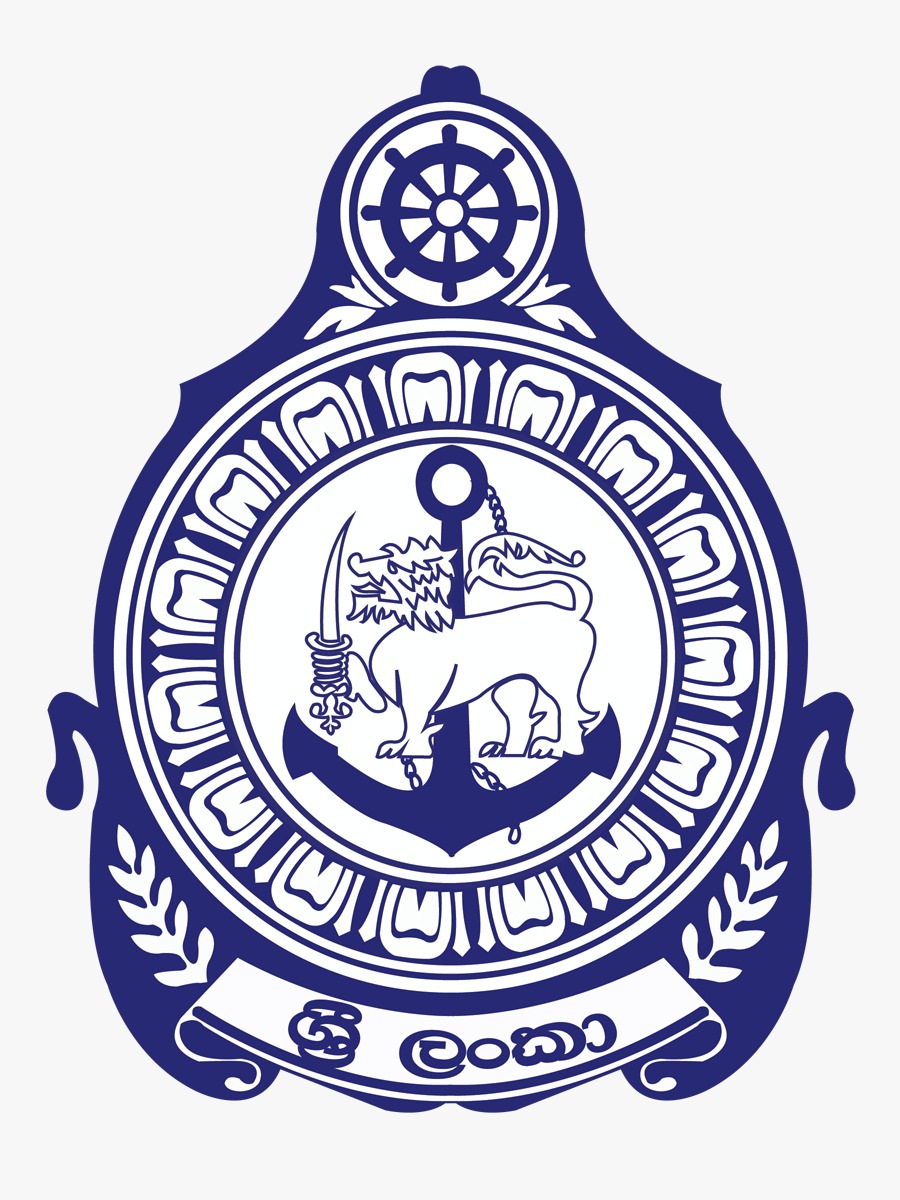
A special naval operation at sea led to the interception of a craft with packages suspected to be narcotics.
More details regarding the incident will be released as they become available.
(Navy Media)
Latest News
Establish a clean local governance system that utilizes budget allocations transparently for rural development – Prime Minister
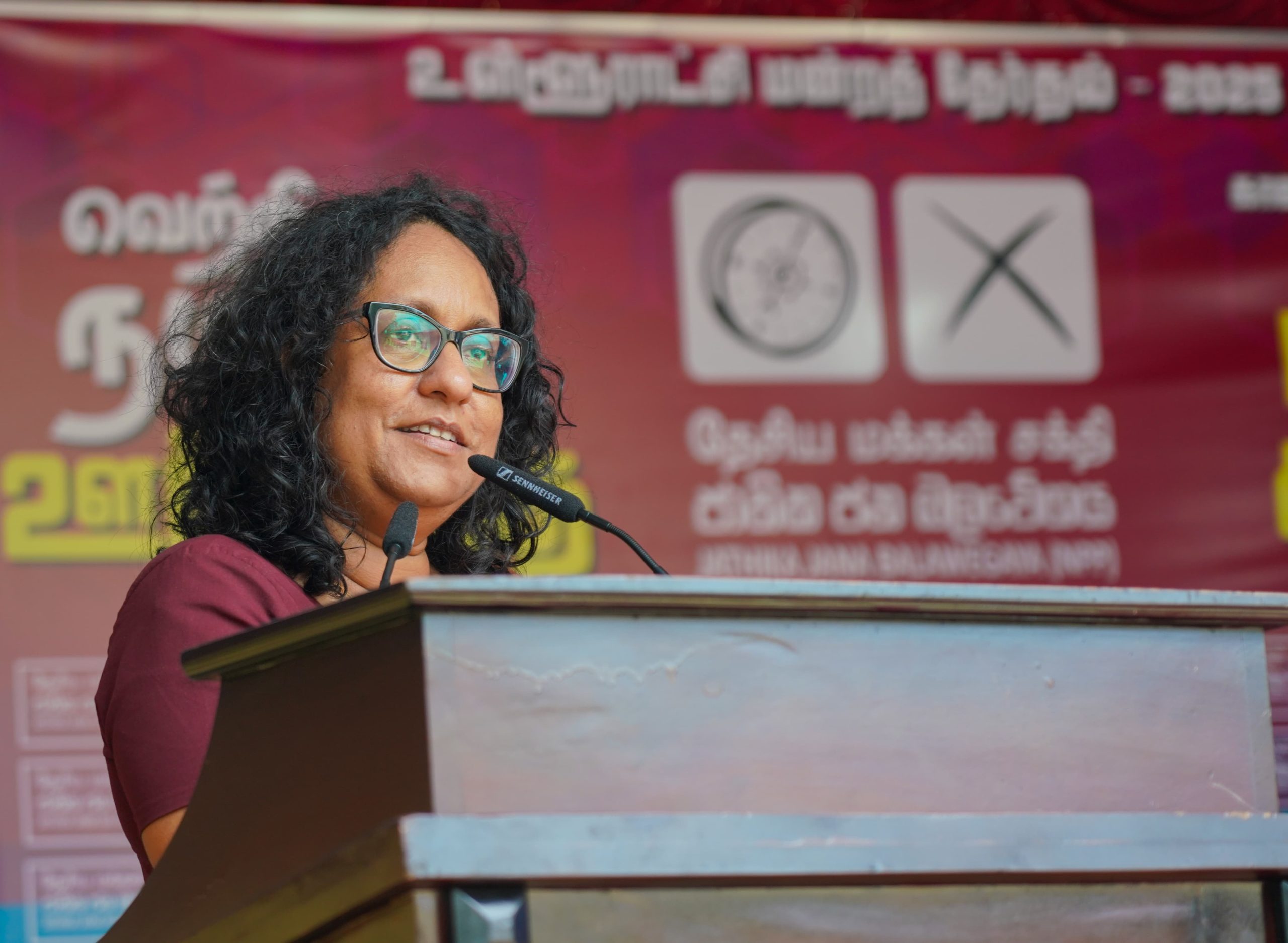
Prime Minister Dr. Harini Amarasuriya emphasized the need to create a clean and transparent local governance system that effectively utilizes budget allocations for the development of the rural sector.
The Prime Minister made these remarks on Friday (11), while addressing a public gathering held in Karainagar, Jaffna.
Elaborating further, Prime Minister Dr. Harini Amarasuriya stated:
“This country is rich in cultures and traditions and inherits a proud and prosperous history.
I was deeply moved by the information I received about Karainagar. In 1977, around 80,000 people lived in Karainagar. Unfortunately, today it has dropped to 10,500. What happened to the rest of the people? I also learned that Karainagar is home to some of the most educated and affluent people in the Northern Province. That is remarkable, but the issue is that in order to become educated and affluent, they were forced to leave Karainagar.
Who speaks up for those who could not leave? They are citizens of this country. They are entitled to have equal rights like everyone else does. As the Minister of Education, I looked into the education system in Karainagar. I discovered that there are only two schools offering GCE Advanced Level education, with only two teachers in total. Further, all students who have passed the Grade 5 scholarship exam leave Karainagar to Jaffna for further education.
Throughout the years, there were changes in governments, presidents, national administrations, members of parliament representing this area, local governments, and provincial councils but what have they done to uplift the education of Karainagar?
Education increases the value and prosperity of people. Education is vital as such. However, for decades, the right to quality education has been denied in this region. In addition, there is a severe water issue in Karainagar. Access to clean drinking water which is a basic necessity, comes at a cost to the people in this area. Various projects launched to provide drinking water have never been completed due to corruption.
Further, roads, transport, and many other services have deteriorated due to corruption at the local level. It has been 16 years since the war ended yet what has changed since then? Why have these issues not yet been resolved? That is why the upcoming local government elections are crucial. Problems at the local level must be addressed by local government institutions.
About a month ago, the first budget of the government has been passed.
A significant allocation has been made from all local government accounts for education, health, public welfare, infrastructure, and public transportation but these funds must be spent wisely.
For that, local governments should be governed by clean and corruption-free environment. Therefore, in this election, we must elect people who are free from corruption and dedicated to the purpose of serving the public. In 2024, the people of this country made a decision to change the political culture. On May 6, they will once again have the opportunity to make a thoughtful decision for the betterment of their villages.”
During the event, Minister of Fisheries . Ramalingam Chandrasekar also shared his views:
“Today, the political morality we expected for has taken root in this country. Unlike the governance of previous governments, the representatives of the current government are not exercising the power to enrich themselves and some even do not hesitate to return their salaries for serving the general public.
Today, the public service receives higher salaries, and the government is taking possible decision for the benefit of the people.”
The event was attended by Members of Parliament Shri Bhavan and Ilayankumar, along with other public representatives and candidates contesting in the local government elections.


[Prime Minister’s Media Division]
Latest News
Warm Weather Advisory issued for Eastern and Uva provinces and Polonnaruwa and Mullaitivu districts.
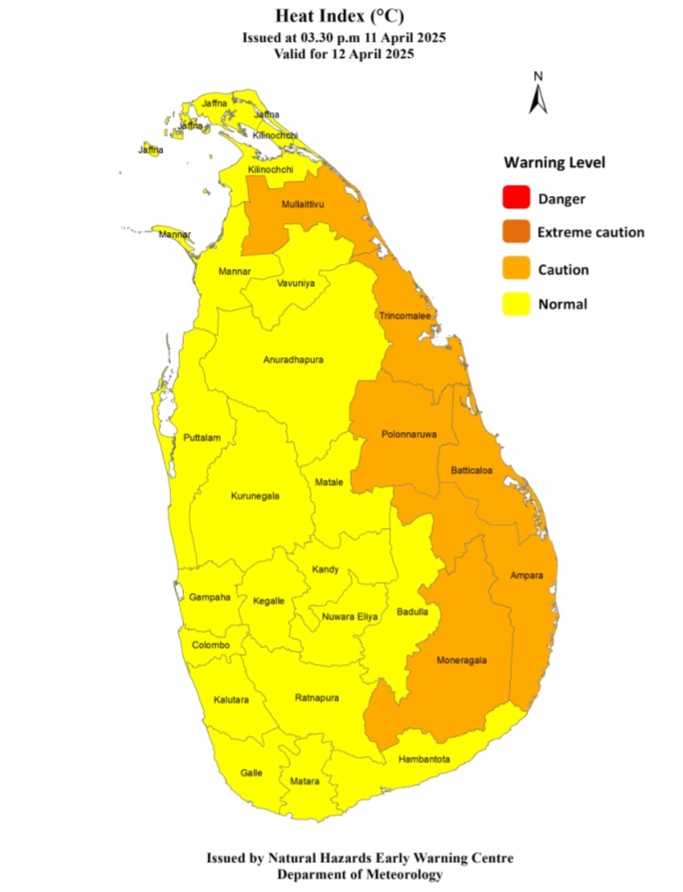
Warm Weather Advisory
Issued by the Natural Hazards Early Warning Centre of the Department of Meteorology for 12th April 2025.
The public are warned that the Heat index, the temperature felt on human body is likely to increase up to ‘Caution level’ at some places in Eastern and Uva provinces and Polonnaruwa and Mullaitivu districts
The Heat Index Forecast is calculated by using relative humidity and maximum temperature and this is the condition that is felt on your body. This is not the forecast of maximum temperature. It is generated by the Department of Meteorology for the next day period and prepared by using global numerical weather prediction model data.
Effect of the heat index on human body is mentioned in the table below and it is prepared on the advice of the Ministry of Health and Indigenous Medical Services.

ACTION REQUIRED
Job sites: Stay hydrated and takes breaks in the shade as often as possible.
Indoors: Check up on the elderly and the sick.
Vehicles: Never leave children unattended.
Outdoors: Limit strenuous outdoor activities, find shade and stay hydrated. Dress: Wear lightweight and white or light-colored clothing.
Note:
In addition, please refer to advisories issued by the Disaster Preparedness & Response Division, Ministry of Health in this regard as well. For further clarifications please contact 011-7446491.
-

 Business5 days ago
Business5 days agoColombo Coffee wins coveted management awards
-

 Features6 days ago
Features6 days agoStarlink in the Global South
-

 Features1 day ago
Features1 day agoRobbers and Wreckers
-
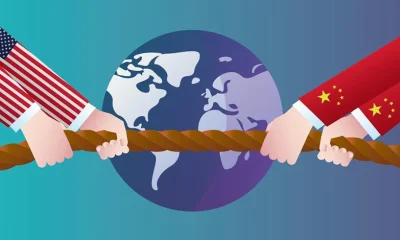
 Features3 days ago
Features3 days agoSri Lanka’s Foreign Policy amid Geopolitical Transformations: 1990-2024 – Part III
-
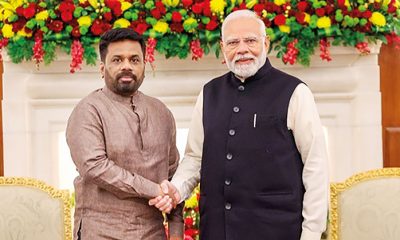
 Features6 days ago
Features6 days agoModi’s Sri Lanka Sojourn
-

 Midweek Review3 days ago
Midweek Review3 days agoInequality is killing the Middle Class
-
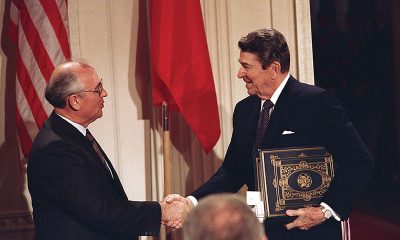
 Features5 days ago
Features5 days agoSri Lanka’s Foreign Policy amid Geopolitical Transformations: 1990-2024 – Part I
-
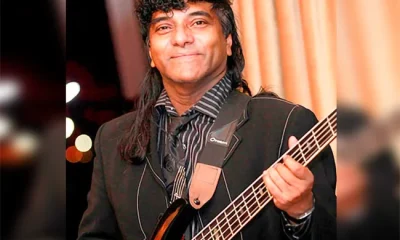
 Features4 days ago
Features4 days agoA brighter future …


